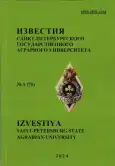Application of the finite ratio method to energy analysis of irradiation process steps in optical electrotechnologies
- Authors: Rakutko S.A.1, Gulin S.V.2
-
Affiliations:
- Institute for Engineering and Environmental Problems in Agricultural Production (IEEP) – branch of FSAC VIM
- Saint-Petersburg State Agrarian University
- Issue: No 1(75) (2024)
- Pages: 141-150
- Section: Agroengineering and food technology
- URL: https://journals.rcsi.science/2078-1318/article/view/304746
- DOI: https://doi.org/10.24412/2078-1318-2024-1-141-150
- ID: 304746
Cite item
Full Text
Abstract
The most important problem in agro-industrial complex is the problem of energy saving. Increasing the energy efficiency of optical electro-technologies, which use optical radiation as a specific energy factor, seems to be a very science-intensive task. The Finite Ratio Method (FRM) was developed by Professor V.N. Karpov as a set of operations based on the analysis of energy consumption in static and dynamic processes. The method is an important tool for the analysis and optimisation of energy-technological processes, as well as for the development of energy-saving systems according to a single indicator of energy efficiency – the energy intensity of the process. The aim of the research is to adapt FRM for its use in irradiation plants with gas-discharge lamps. The methodology of FRM application for revealing the energy saving reserves provides 'marking' of the scheme, which consists in allocation of energy blocks corresponding to the stages of energy conversion. In the paper, two blocks are allocated for the circuit with a discharge lamp: ballast (conversion of total energy into active energy) and discharge lamp (conversion of active energy into light flux energy). Expressions for calculating the energy intensity of these blocks are presented. In the first series of experiments, the operation of the LB 40 type lamp with active, inductive and capacitive ballasts was investigated. In the second series of experiments the operation of the same lamp with inductive ballasts of ABI and UBI brands was investigated. Instantaneous values of current, voltage and luminous flux were determined using oscilloscope C1-82. The total power consumption of the circuit with the investigated ballast brands is 0.022 and 0.017 VA.Lm-1 respectively. The efficiency of replacing ABI ballast with UBI as an energy saving measure, according to FRM, is 26%. Thus, the possibility of using FRM to analyse electrical circuits with discharge lamps fed from ballasts of different brands is shown.
About the authors
S. A. Rakutko
Institute for Engineering and Environmental Problems in Agricultural Production (IEEP) – branch of FSAC VIM
Author for correspondence.
Email: sergej1964@yandex.ru
Doc.Sci. (Eng), chief researcher St. Petersburg, Russia
S. V. Gulin
Saint-Petersburg State Agrarian University
Email: serg.gulin2010@yandex.ru
Cand. Sci. (Eng), Associate Professor St. Petersburg, Russia
References
- Karpov V. N. Energosberezhenie. Metod konechnyh otnoshenij [Energy saving. Finite ratio method]. St. Petersburg, 2005. – 146 p.
- Karpov V. N. (2019). Prakticheskoe upravlenie energoeffektivnost'yu predpriyatiya [Practical management of enterprise energy efficiency] // Izvestiya Sankt-Peterburgskogo gosudarstvennogo agrarnogo universiteta, no. 2, pp. 118–125.
- Karpov V. N., Yuldashev Z. Sh., Yuldashev R. Z. (2022). Metodika issledovaniya po opredeleniyu energoeffektivnosti obrabotki vody UF [Research methodology for determining the energy efficiency of UV water treatment] // Peasant, vol. 97, no. 4, pp. 88–93.
- Gulin S. V., Rakutko S. A. (2012). Effektivnost' spektrostabiliziruyushchego regulirovaniya potoka razryadnyh istochnikov izlucheniya s pozicij prikladnoj teorii energosberezheniya [Efficiency of spectrum-stabilizing regulation of the flow of discharge radiation sources from the perspective of applied theory of energy saving] // Izvestia of the Saint Petersburg State Agrarian University, no. 28, pp. 377–383.
- Ovchukova S. A., Kondratieva N. P., Kovalenko O. Yu. (2021). Energy saving in lighting technologies of agricultural production // Light & Engineering, vol. 29, no. 2, pp. 21–25.
- Karpov V. N., Rakutko S. A. Energosberezhenie v opticheskih elektrotekhnologiyah APK. Prikladnaya teoriya i chastnye metodiki [Energy saving in optical electrical technologies of agro-industrial complex. Applied theory and private methods]. St. Petersburg: SPbGAU, 2010. – 100 p.
- Levchenko V. A. (2015). Uvelichenie fizicheskogo sroka sluzhby moshchnyh gazorazryadnyh lamp nizkogo davleniya [Increasing the physical service life of high-power low-pressure gas-discharge lamps] // Applied Physics, no. 5, pp. 90–94.
- Seredenko R. A. (2023). Klassifikaciya elektricheskih razryadov na osnove razlichnyh parametrov [Classification of electrical discharges based on various parameters] // In the collection: Quality of life of the population and ecology. Penza, pp. 116–119.
- Kozlov D. G., Savickas R. K. (2015). K voprosu o processah zazhiganiya i stabilizacii funkcionirovaniya gazorazryadnyh lamp [On the issue of ignition processes and stabilization of the functioning of gas-discharge lamps] // Bulletin of Voronezh State Agrarian University, vol. 45, no. 2, pp. 61–64.
- Lister G., Liu Y. (2017). Low-Pressure Gas Discharge Lamps // In: Handbook of Advanced Lighting Technology, pp. 1065–1079.
- Sapryka A. V., Vendin S. V., Roshchubkin P. V. (2019). Vliyanie volt-ampernyh harakteristik gazorazryadnyh lamp na rabotu osvetitel'nyh ustanovok v gorodskih elektricheskih setyah [The influence of current-voltage characteristics of gas-discharge lamps on the operation of lighting installations in urban electrical networks] // In the collection: High Technology and Innovation, pp. 54–58.
- Rakutko S. A. (2014). Energodinamicheskie osnovy prikladnoj teorii energosberezheniya [Energy-dynamic foundations of the applied theory of energy saving] // Izvestia of Saint Petersburg State Agrarian University, vol. 37, pp. 268–271.
- Rakutko E. N., Rakutko S. A. (2024). Energeticheskaya ocenka effektivnosti ballastov dlya gazorazryadnyh istochnikov sveta [Energy assessment of the efficiency of ballasts for gas-discharge light sources] // Izvestia of the Nizhnevolzhsky Agro-University Complex: Science and Higher Professional Education, vol. 73, no. 1.
- Laptev V. A., Solovyov Yu. M. (2002). Analiz harakteristik gazorazryadnoj lampy v elektricheskoj cepi sinusoidal'nogo toka [Analysis of the characteristics of a gas-discharge lamp in an electrical circuit of sinusoidal current] // Design, Use and Reliability of Agricultural Machines, vol. 1, no. 1, pp. 76–81.
- Malyshev A. (2021). Novoe – horosho zabytoe staroe: osobennosti pitaniya baktericidnyh i lyuminescentnyh lamp i vybor EPRA dlya nih [New – well forgotten old: power supply features of bactericidal and fluorescent lamps and the choice of electronic ballasts for them] // Poluprovodnikovaya svetotekhnika, vol. 74, no. 6, pp. 26–30.
Supplementary files









